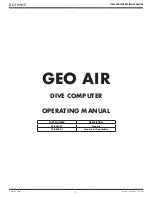
HydroSense II Soil Moisture Measurement System
21
9.2
Probe Insertion
For accurate, repeatable measurements, the rods of the CS658/9 sensor must be
fully inserted into the soil. It is normally inserted vertically, but this is not
mandatory. Since the water content is averaged over the length of the rods, the
reading from a 20cm probe inserted vertically will be the average of the soil
moisture over the top 20cm, however the same rods inserted at 45° will yield an
average of the top 10cm. This is often used for shallow rooted crops such as turf
to measure the average water content in the root zone of the plant, however it is
important that the sensor rods are inserted completely and that none of the rod
surface is exposed when measurements are made.
The measurement volume of the CS658/9 sensors vary somewhat with soil type,
however as a guide, it extends along the full length of the rods and outward
radially from each rod a distance of approximately 3cm. It is important that this
volume should be completely immersed in soil.
Soil is not a homogeneous medium on the scale of most soil water content
measurement methods. Soil features such as cracks, rocks, pore size distribution,
plant roots and texture layers are not always distributed evenly throughout a
measured profile. If the water content over a large area such as a cropped field is
to be determined, several measurements may be required to establish a
representative measurement.
9.3
Soil factors which can affect the Measurement
The HydroSense II is very sensitive to changes in dielectric permittivity and the
probe has water content measurement resolution better than 0.1%. While the
HydroSense II is predominantly sensitive to dielectric permittivity (and
consequently soil water content), other physical properties of the soil can affect
the measurement. If the soil contains a large amount of clay or has high electrical
conductivity (EC), the applied signal can be attenuated and this affects detection
of the reflected signal in the probe electronics. Very high organic matter has a
similar effect. The HydroSense II will still respond to changes in water content
but not the same as if the attenuation factors were present in small non-
interfering amounts. The calibration coefficients used to transform measured
travel time to water content were determined in laboratory studies on typical
soils. User determined coefficients can be applied to the period value that is
displayed in the water content section of the
main screen
.
Rocky soils can make rod insertion difficult and introduce variability in water
contents measurements taken in the same general area. The rocks occupy space
otherwise occupied by the fine soil fraction but do not hold water in the same
manner as soil. If two proximal measurements are made in rocky soil, the
measured water content can differ by several percent if a large rock occupies part
of the sensitive volume of one measurement but not the other.
















































